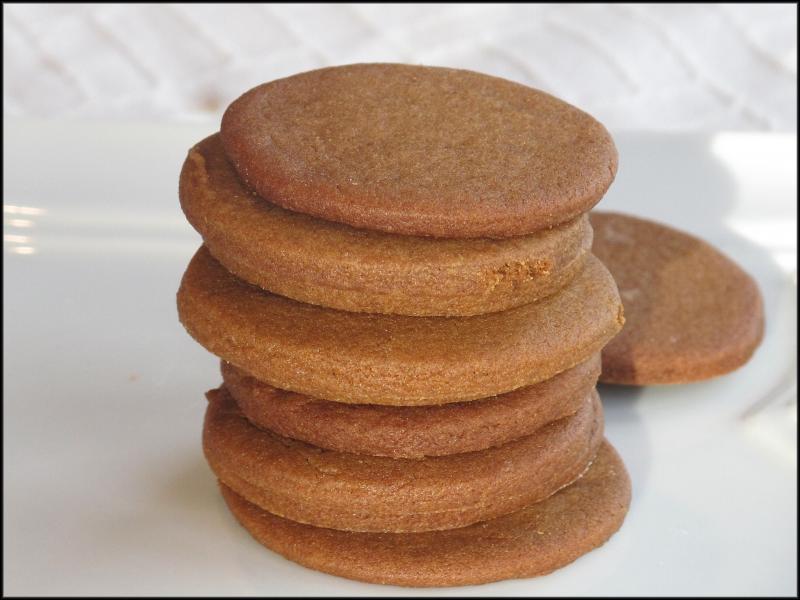An ode to old cookbooks: Gingerbread a mainstay of early American cookery
Last week, the Lewes Historical Society invited me to present a talk for their monthly Speakers Series at the Rollins Center. For the topic, I chose “How Cookbooks Tell Our History,” as I am fascinated by old cookbooks and find what they include, as well as what they omit, can be a window into the culture of the time in which they were written.
I set out a selection of cookbooks for the attendees to browse, ranging from reprints of early English and American cookbooks to the familiar Fanny Farmer to pamphlets published in the 20th century. From the Archives of the Lewes Historical Society, I was able to share “Tested Lewes Recipes” from 1904-16 and the 1921 Blue Hen’s Chickens’ Cook Book.
For the content of my talk, I began with a hieroglyph from the tomb of Ramesses III that depicted how coiled bread loaves were made. The first step illustrated in the panel showed men stomping grapes to make a liquid to be used both as sweetener and leavening. After kneading and forming the dough, it’s boiled, then baked, not unlike the process for making bagels.
The missing information in this recipe is whether this was for a special occasion or if this type of bread was served as everyday food. Clearly there was a need for a large staff or servants and specialized cooking tools, not something for an ordinary person in Egypt. The same sort of story is told by “A Forme of Cury” written in 1390 by the Master Cooks of Richard III. These recipes were for a royal household, not an average citizen.
We’re still in the realm of instructions for servants in upper-crust homes when we read the works of Eliza Smith, Hannah Glasse and Susannah Carter. Although each of their British cookbooks was reprinted in America, they still reflected English culinary traditions and ingredients. The first truly American work appeared in 1796, when Amelia Simmons (who described herself as “An American Orphan”) published American Cookery.
She featured New World foods such as squash, corn meal, Jerusalem artichokes, tomatoes, and turkey served with cranberry sauce. This was the earliest appearance of recipes for “all grades of life.” The next change in the content of cookbooks came with Sarah Josepha Hale in 1839, where we saw guidance on household management and child-rearing as well as cookery.
We took a brief southern detour to look at Mary Randolph’s book, The Virginia Housewife. She was a member of the elite plantation society of the South, known for her elaborate parties and lavish entertainments. The foods in her collection needed the many hands of servants to prepare and also featured some ingredients brought to America by enslaved Africans.
When Fanny Farmer published her famous Boston Cooking-School Cookbook in 1896, we were introduced to an entirely new way of writing recipes. Instead of a conversational paragraph where amounts of each ingredient were not included, cooking time and temperatures were vaguely described, and much was left to the experience of the cook, Fanny Farmer gave us discipline.
She focused on standardized measures, listed the amount of each ingredient at the start of the recipe and included detailed instructions on each step. While very few cookbooks ever included a recipe for baking bread (because readers already knew how) Fanny Farmer provided explicit guidelines on bread-baking, the science of wheat and how to have it milled.
Since the early 20th century, we have seen thousands of cookbooks, from community recipe collections to product-specific booklets to those written by celebrity chefs or to explain specialty diets. A few standard cookbooks have persisted in multiple editions, including Joy of Cooking and Betty Crocker, but today we’re seeing most recipes posted in online sources.
At the conclusion of my talk, I shared two versions of gingerbread, a mainstay of early American cookery. The first cookies were from Lloyd’s Market in Lewes, and the others I made from an Amelia Simmons recipe, originally called “koekies” or “little cakes” in Dutch. I’ve included a more readable form of her recipe for “gingersnaps” as well as one for a softer cake-style version flavored with ginger and molasses.
Traditional Gingersnaps
1/2 C packed brown sugar
1/2 C molasses
1/2 C butter
2 C flour
1 t baking soda
2 t ground ginger
1 t cinnamon
pinch salt
flour for rolling dough
Combine sugar, molasses and butter in a saucepan and heat over medium until butter melts, stirring occasionally. Meanwhile, whisk together flour, baking soda, ginger, cinnamon and salt in a large mixing bowl. Form a well in the center of the dry ingredients and pour in the sugar mixture. Stir with a wooden spoon until smooth. Cover with plastic wrap, making sure the wrap is directly on the dough. Chill for one hour. Preheat oven to 350 F. Line baking sheets with parchment paper or silicon baking pad. Sprinkle flour on working surface and take one-third of dough from the bowl. Roll to a flat sheet 1/8-inch thick. Cut with a cookie cutter and place on baking sheets. Bake until firm, about 11 to 12 minutes. Remove from oven and let sit for a minute or so, then transfer to a baking rack to cool. Repeat with remaining dough. Store in an airtight container. Yield: 5 dozen cookies.
Gingerbread Cake
1 1/2 C flour
1 t baking soda
2 t ground ginger
1 t cinnamon
1/4 t cloves
4 T melted butter
2/3 C packed brown sugar
2/3 C molasses
2/3 C boiling water
1 egg
confectioners sugar
Preheat oven to 350 F. Coat the inside of a 9-inch square pan with nonstick cooking spray. In a mixing bowl, whisk together flour, baking soda, salt, ginger, cinnamon and cloves; set aside. In a large bowl, whisk together the melted butter, brown sugar, molasses and boiling water. Allow the mixture to cool to lukewarm and whisk in egg. Add the dry ingredients to the wet ingredients and stir until just combined and without lumps. Pour the batter into the prepared pan and bake until the edges look dark and the middle feels firm to the touch, about 35 minutes. Set the pan on a rack to cool slightly, then cut into squares and serve dusted with confectioners sugar.






















































